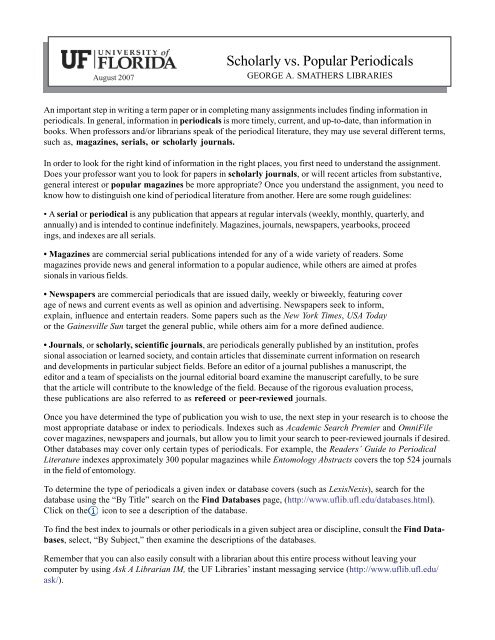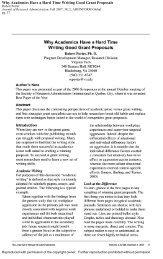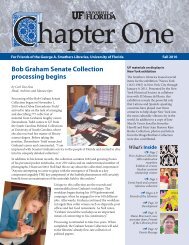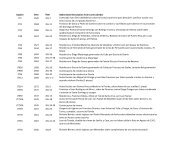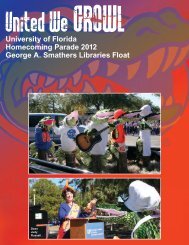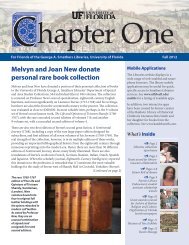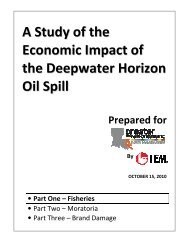Scholarly vs. Popular Periodicals - George A. Smathers Libraries
Scholarly vs. Popular Periodicals - George A. Smathers Libraries
Scholarly vs. Popular Periodicals - George A. Smathers Libraries
You also want an ePaper? Increase the reach of your titles
YUMPU automatically turns print PDFs into web optimized ePapers that Google loves.
August 2007<br />
<strong>Scholarly</strong> <strong>vs</strong>. <strong>Popular</strong> <strong>Periodicals</strong><br />
GEORGE A. SMATHERS LIBRARIES<br />
An important step in writing a term paper or in completing many assignments includes finding information in<br />
periodicals. In general, information in periodicals is more timely, current, and up-to-date, than information in<br />
books. When professors and/or librarians speak of the periodical literature, they may use several different terms,<br />
such as, magazines, serials, or scholarly journals.<br />
In order to look for the right kind of information in the right places, you first need to understand the assignment.<br />
Does your professor want you to look for papers in scholarly journals, or will recent articles from substantive,<br />
general interest or popular magazines be more appropriate? Once you understand the assignment, you need to<br />
know how to distinguish one kind of periodical literature from another. Here are some rough guidelines:<br />
• A serial or periodical is any publication that appears at regular intervals (weekly, monthly, quarterly, and<br />
annually) and is intended to continue indefinitely. Magazines, journals, newspapers, yearbooks, proceed<br />
ings, and indexes are all serials.<br />
• Magazines are commercial serial publications intended for any of a wide variety of readers. Some<br />
magazines provide news and general information to a popular audience, while others are aimed at profes<br />
sionals in various fields.<br />
• Newspapers are commercial periodicals that are issued daily, weekly or biweekly, featuring cover<br />
age of news and current events as well as opinion and advertising. Newspapers seek to inform,<br />
explain, influence and entertain readers. Some papers such as the New York Times, USA Today<br />
or the Gainesville Sun target the general public, while others aim for a more defined audience.<br />
• Journals, or scholarly, scientific journals, are periodicals generally published by an institution, profes<br />
sional association or learned society, and contain articles that disseminate current information on research<br />
and developments in particular subject fields. Before an editor of a journal publishes a manuscript, the<br />
editor and a team of specialists on the journal editorial board examine the manuscript carefully, to be sure<br />
that the article will contribute to the knowledge of the field. Because of the rigorous evaluation process,<br />
these publications are also referred to as refereed or peer-reviewed journals.<br />
Once you have determined the type of publication you wish to use, the next step in your research is to choose the<br />
most appropriate database or index to periodicals. Indexes such as Academic Search Premier and OmniFile<br />
cover magazines, newspapers and journals, but allow you to limit your search to peer-reviewed journals if desired.<br />
Other databases may cover only certain types of periodicals. For example, the Readers’ Guide to Periodical<br />
Literature indexes approximately 300 popular magazines while Entomology Abstracts covers the top 524 journals<br />
in the field of entomology.<br />
To determine the type of periodicals a given index or database covers (such as LexisNexis), search for the<br />
database using the “By Title” search on the Find Databases page, (http://www.uflib.ufl.edu/databases.html).<br />
Click on the icon to see a description of the database.<br />
To find the best index to journals or other periodicals in a given subject area or discipline, consult the Find Databases,<br />
select, “By Subject,” then examine the descriptions of the databases.<br />
Remember that you can also easily consult with a librarian about this entire process without leaving your<br />
computer by using Ask A Librarian IM, the UF <strong>Libraries</strong>’ instant messaging service (http://www.uflib.ufl.edu/<br />
ask/).
Trade & Professional<br />
Purpose: To provide information, in a<br />
general manner, to a broad audience of<br />
concerned citizens.<br />
These periodicals may be quite attractive,<br />
even glossy, in appearance. Some<br />
may be in newspaper format. Articles<br />
often have many illustrations, usually<br />
photographs.<br />
These periodicals sometimes cite sources<br />
but they often do not.<br />
Articles may be written by a scholar, a<br />
well-known professional or other expert<br />
in the subject addressed in the article.<br />
Freelance writers or members of the<br />
editorial staff may also contribute<br />
articles.<br />
The language of these publications is<br />
geared to any educated audience. A<br />
certain level of interest and intelligence,<br />
though not expertise, is assumed.<br />
Professional and trade magazines report<br />
on developments in various fields or<br />
industries.<br />
They are generally published by<br />
commercial enterprises or individuals,<br />
although some emanate from specific<br />
professional organizations.<br />
EXAMPLES:<br />
Advertising Age, Billboard, Business<br />
Week, Atlantic,The Economist, Harpers,<br />
Mother Jones, The Nation,New Scientist,<br />
New York Times Magazine,Scientific<br />
America, The Smithsonian,U.S. News &<br />
World Report, Variety<br />
<strong>Popular</strong><br />
Newspapers<br />
Purpose: To entertain the reader, to sell<br />
the products of their advertisers, and/or<br />
promote a viewpoint.<br />
<strong>Popular</strong> periodicals come in various<br />
formats, but they are usually glossy with<br />
colorful, flashy covers and photos<br />
intended to entice the readers and<br />
buyers at newsstands.<br />
<strong>Popular</strong> magazines rarely cite sources.<br />
The information is often second or<br />
third-hand and the original source is<br />
sometimes obscure.<br />
Purpose: To report news, and cultural<br />
events through news analysis and<br />
reporting. Papers also feature photographs,<br />
weather reports, editorials, essays, personal<br />
and syndicated columns, letters to the<br />
editors, comic strips, cartoons, advertising<br />
and reviews of books, movies and music.<br />
Coverage ranges from national and<br />
international (New York Times, Washington<br />
Post) to events of local interest<br />
(Gainesville Sun, or the St. Augustine<br />
Record) depending upon the audience<br />
for the paper.<br />
Articles are written by staff members or<br />
free-lance writers.<br />
Articles are usually very short, written<br />
in simple language and designed to<br />
meet a minimal education level. There<br />
is generally little depth to the articles’<br />
content.<br />
EXAMPLES:<br />
Cosmopolitan, Ebony, Essence,<br />
Family Circle, Mother Earth News,<br />
Ms., Omni, Psychology Today,<br />
Parents Magazine, People Weekly,<br />
<strong>Popular</strong> Mechanics, Readers Digest,<br />
Rolling Stone, Sports Illustrated,<br />
USA Today<br />
Newspapers are typically published<br />
daily, twice weekly or once a week,<br />
though there are exceptions. Traditional<br />
papers are printed on low quality tabloid<br />
sized paper, as well as online.<br />
Articles are written by professional<br />
journalists.<br />
Newspapers are useful primary sources<br />
of information, printing full text of<br />
speeches, first hand reports of events,<br />
and elusive facts about local issues or<br />
events.<br />
EXAMPLES:<br />
Atlanta Journal and Constitution<br />
Miami Herald, Boston Globe<br />
Still Confused?<br />
Sometimes it is hard to tell if a periodical is scholarly or popular, even after following<br />
the tips given in this handout. A periodical directory will give a description<br />
of the periodical’s publishing history, audience and tell if it is peer-reviewed.<br />
Ulrich’s Periodical Directory http://ulrichsweb.com/<br />
JSR 7/2007<br />
<strong>Scholarly</strong>, Peer-Reviewed<br />
Purpose: To report on original research<br />
or experimentation in order to make<br />
such information available to the rest<br />
of the scholarly community.<br />
<strong>Scholarly</strong> journals generally have a<br />
sober, serious look. The articles<br />
contain mostly text, with many graphs<br />
and charts, but few photos. <strong>Scholarly</strong><br />
journals always cite their sources in<br />
the form of footnotes or bibliographies.<br />
Articles are written by a scholar in the<br />
field or by someone who has done<br />
research in the field.<br />
The language of scholarly journals is<br />
that of the discipline covered. It<br />
assumes some scholarly background<br />
on the part of the reader.<br />
Many scholarly journals (but not all)<br />
are published by a specific<br />
professional organization.<br />
EXAMPLES:<br />
American Anthropologist (Journal of<br />
the American Anthropology Association)<br />
JAMA: Journal of the American<br />
Medical Association<br />
Journal of Marriage and the Family<br />
(Published by the National Council on<br />
Family Relations)<br />
PMLA (Modern Language Association)<br />
Psychological Bulletin (Published by<br />
the American Psychological<br />
Association)<br />
Science (Journal of the American<br />
Association for the Advancement of<br />
Science)


